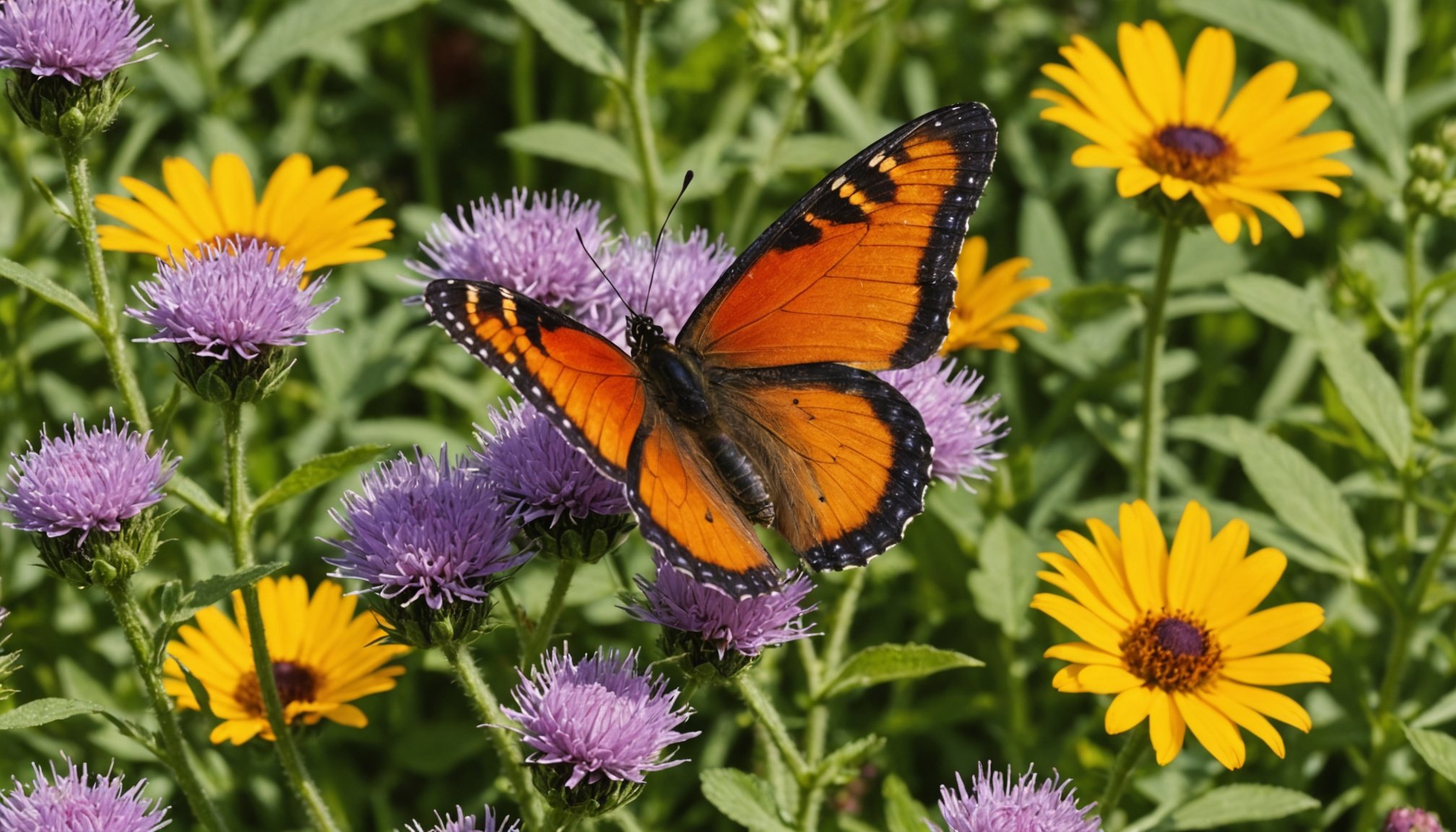Understanding Biodiversity and Its Importance
Biodiversity refers to the variety of life found on Earth, including ecosystems, species, and genetic diversity. It plays a critical role in maintaining balanced ecosystems. In the UK, biodiversity supports complex interactions within ecosystems, ensuring the stability and resilience of environments.
Among the vibrant components of biodiversity are butterflies. These delicate insects serve key roles in the food chain and as pollinators. By transferring pollen, they facilitate the reproduction of flowering plants, which is essential for the production of fruits and seeds. Their presence also indicates a healthy environment. Butterflies provide food for other organisms higher up the food chain, contributing further to ecological balance.
Additional reading : Is a standard tropical aquarium the perfect home for your axolotl?
Currently, biodiversity in the UK faces significant threats from habitat loss, climate change, urbanization, and pollution. These influences can lead to a decline in essential species like butterflies, disrupting ecosystems and affecting services they provide.
Understanding the intricate web of life and the importance of each species is crucial to preserving biodiversity. Efforts to protect and restore environments, such as creating protected areas and promoting conservation practices, are vital. These actions ensure that UK ecosystems continue to thrive and support diverse life forms. Addressing these challenges can help preserve butterfly habitats, contributing to the overall health of ecosystems.
Also read : Vital insights on monitoring shell health in hermann”s tortoises: a comprehensive guide to their well-being
Selecting the Right Plants for Your Butterfly Haven
Creating a butterfly haven begins with choosing the right butterfly-friendly plants. These are typically native flora that provide essential nectar sources for butterflies, which are active throughout various seasons. One crucial aspect is ensuring your garden includes a mix of nectar-rich and host plants. Host plants support butterfly larvae, allowing them to complete their life cycles in your garden. Common choices include nettles for some native butterfly species in the UK.
When designing your garden, focus on incorporating plants that bloom at different times of the year, ensuring butterflies have access to food year-round. This strategy helps sustain butterfly populations and enhances your garden’s appeal. Look into species such as buddleia and lavender, which are well-known nectar sources.
Consider the specific needs of your local butterfly species when selecting plants. Varieties like marjoram and sedum can attract and support the distinctive UK butterflies. Combining native flora with non-invasive exotic plants can create a dynamic and visually appealing space. By using a diverse array of plants, you can cater to the varied needs of butterflies, ensuring a thriving ecosystem right in your backyard.
Creating Ideal Habitats for Butterflies
Designing butterfly-friendly gardens requires an understanding of how to create suitable butterfly habitats. Key elements include diverse planting areas, water features, and sheltered spots. These components form microclimates that cater to different butterfly species, ensuring their needs are met throughout their lifecycle.
Incorporating microhabitats within your garden can significantly enhance its appeal to butterflies. For instance, tall grasses and dense shrubs offer shelter from predators and harsh weather, allowing butterflies to rest safely. Integrating basking stones or logs provides sun-warmed surfaces, perfect for butterflies to absorb heat and regulate their body temperature.
Adding water sources in the form of shallow puddles or birdbaths with stones for perching can support butterflies during dry spells. They serve as essential hydration points and nutrient-rich sipping sites for these delicate creatures.
Creating sunlit areas while maintaining shaded zones mimics natural environments. Such balanced garden designs foster rich biodiversity. By considering aspects like plant diversity and layout, gardeners can create thriving butterfly habitats. This approach ensures butterflies find ample food, shelter, and suitable conditions, ultimately supporting their survival and contributing to the overall health of UK ecosystems.
Sustainable Gardening Practices for Biodiversity
Incorporating sustainable gardening practices can significantly enhance biodiversity and create thriving UK ecosystems. By adopting eco-friendly practices, gardeners contribute positively to the environment. A key aspect is the use of organic methods to maintain plant health, which involves avoiding harmful chemicals and pesticides. Instead, natural alternatives such as neem oil or insecticidal soap can effectively manage pests while protecting beneficial insects.
Composting is another vital technique in sustainable gardening. By turning organic waste into nutrient-rich compost, gardeners can improve soil health and structure, fostering robust plant growth without synthetic fertilizers. Select plants wisely to bolster biodiversity; incorporating native flora supports local wildlife and reduces the need for excessive watering or fertilization.
Practicing crop rotation and planting cover crops can enhance soil fertility and minimize erosion, further contributing to a sustainable garden environment. Encouraging pollinators with a diverse range of nectar sources not only benefits butterflies but also boosts plant reproduction.
Gardening sustainably not only aids biodiversity but also results in more resilient landscapes. By promoting eco-conscious habits, individuals can create beautiful and productive environments that support butterfly habitats and ensure ecological balance. Embracing these practices leads to healthier gardens and a healthier planet.
Engaging Your Community and Promoting Biodiversity
Engaging your community in biodiversity initiatives offers numerous benefits, fostering awareness and collaboration. Local biodiversity initiatives can become a powerful tool for change. By inviting neighbours into your garden, you create a welcoming environment for learning and inspiration. Hosting workshops or garden tours provides practical insights and showcases the beauty and functionality of butterfly habitats.
Educational programs are essential for spreading knowledge about biodiversity’s importance. Incorporating educational resources suitable for everyone can make learning accessible and engaging. Schools and community centers are ideal venues to start collaborations and involve all age groups in these valuable lessons.
Community involvement can transform local areas into vibrant hubs of biodiversity initiatives. Establishing partnerships with environmental groups and government bodies can amplify efforts. Encourage locals to participate in butterfly counts and habitat restorations. These initiatives not only provide social engagement but reinforce the value of conservation.
Incorporate social media platforms to share stories, updates, and success stories. By creating a sense of community around butterfly projects, participants feel motivated and connected. This can lead to a domino effect, encouraging others to embrace gardening for biodiversity. Through collective actions, communities can significantly impact local UK ecosystems positively.
Case Studies and Success Stories
Examining successful butterfly garden examples in the UK reveals how transformative these spaces can be. Take, for instance, Sheila’s garden in Surrey. Once a bland lawn, Sheila’s space blossomed into a vibrant butterfly haven. Using native flora such as wild marjoram and bird’s-foot trefoil attracted distinctive UK butterflies within months.
Interviews with passionate gardeners like Sheila highlight the satisfaction derived from such projects. They often cite the personal benefits of engaging directly with nature, contributing positively to both local biodiversity and personal well-being. Listening to these success stories can inspire others to follow suit, demonstrating the practical steps and creative solutions employed.
Gardeners emphasize selecting a variety of nectar-rich plants, sustaining butterfly populations throughout the seasons. One key lesson learned involves understanding local butterfly species’ needs, ensuring adequate nectar sources and host plants. Implementing microclimates with sheltered spots provides additional benefits for caterpillars and adult butterflies.
These case studies underscore the importance of community sharing. By engaging with neighbours and sharing experiences, local biodiversity can flourish. The collective impact of individual efforts accumulates, offering not only inspiration but actionable guidance for those ready to take on their own butterfly garden adventure.
The Benefits of Cultivating a Butterfly Haven
Creating a butterfly haven offers profound personal benefits, ecological impact, and mental health advantages. Working closely with nature, individuals often experience a deep sense of fulfillment and joy. This rewarding connection encourages continuous engagement in sustainable practices, enhancing one’s garden and ecosystem overall.
The ecological impact of cultivating butterfly-friendly gardens extends beyond personal satisfaction. These havens contribute significantly to local biodiversity, supporting pollinator populations and promoting healthy UK ecosystems. By offering essential nectar and host plants, gardeners ensure butterflies thrive, maintaining the balance and resilience of local ecosystems.
Spending time in one’s garden also offers remarkable benefits for mental health. Engaging with nature has been shown to alleviate stress and improve mood, providing a serene escape from the fast-paced modern world. The sights and sounds of a bustling butterfly habitat can create a peaceful environment, ideal for reflection and relaxation.
Gardeners gain a sense of accomplishment from witnessing firsthand the positive changes in their surroundings. As butterfly populations flourish, the visual beauty and activity within the garden increase, enhancing its charm and appeal. Ultimately, cultivating a butterfly haven serves as a fulfilling venture that nurtures both nature and the spirit.










